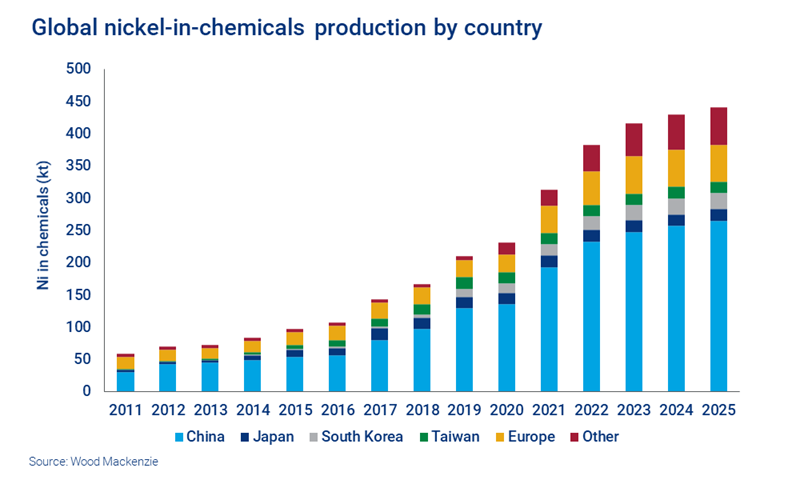How electric vehicles are driving the nickel sulphate market
Demand for EV battery materials will accelerate – despite a 2020 slowdown
1 minute read
Andrew Mitchell
Director, Nickel Research

Andrew Mitchell
Director, Nickel Research
Specialising in nickel for over 20 years, Andrew has a deep understanding of the metals and mining industry.
Latest articles by Andrew
-
Opinion
Four key takeaways from LME 2024
-
Opinion
Nickel and copper: building blocks for a greener future
-
Opinion
How electric vehicles are driving the nickel sulphate market
There has been a surge in demand for nickel sulphate in recent years. Global consumption increased by 28% in 2019, primarily driven by the electric vehicle (EV) market. And as the EV revolution gathers speed, demand for battery materials will accelerate. Can the industry keep pace?
This article draws on the findings of our Global Nickel Sulphate Market report, a highly detailed study of the market, its challenges and opportunities. Fill in the form for a preview of the full report. Or read on for five nickel sulphate FAQs.
1. What’s driving demand for nickel sulphate?
Historically, nickel sulphate has mainly been used in solution as the electrolyte in nickel plating. In recent years, it has also become the preferred chemical feed in the production of cathode materials for nickel-bearing lithium-ion batteries (LiBs) – primarily for EVs.
Nickel metal hydride (NiMH) batteries have long been the preferred power train for hybrid EVs. However, the rise of full battery electric vehicles (BEVs) is likely to be accompanied by a growing preference for nickel-bearing LiBs, such as NMC and NCA technologies.
This doesn’t mean that all BEVs will be powered by batteries containing nickel – other types, such as lithium iron phosphate (LFP), will remain in use. But it does underpin a growing requirement for nickel sulphate.
Demand isn’t coming solely from the EV sector. It will be supplemented by requirements for batteries in energy storage systems. Overall, faster growth of battery manufacturing is a primary requirement of the fight against climate change and will call for investment across the value chain.
2. How fast is consumption growing – and what does it mean for nickel sulphate prices?
Clear growth in consumption has caught the industry’s attention. Globally, nickel consumption (as nickel sulphate) in battery precursor production increased by 28% in 2019, to 162 kt – with China accounting for the lion’s share. By 2025, we forecast world nickel consumption in EV battery materials will increase to 265 kt.
Satisfying growing demand could be challenging for an industry that has generally been slow to add capacity in a timely and cost-effective manner. Existing and prospective nickel producers are being drawn to the possibility of manufacturing sulphate to benefit from the perceived price premiums. These premiums have long been a feature of the plating industry – but in the battery space the situation is much more nuanced.
Our Global Nickel Sulphate Market Study includes an in-depth look at nickel sulphate pricing and premiums – fill in the form at the top of this page for a preview.
3. Where is nickel sulphate currently produced?
Nickel sulphate is a product of primary nickel refineries but is also produced by dissolving pure nickel metal in sulphuric acid. Global production has expanded considerably in recent years, largely due to capacity expansions in China, Japan and Taiwan.
While the wider nickel market has only become focused on the evolution of nickel use in EV batteries over the past two years, Asian nations have known this revolution was coming and have been busy preparing for it since 2012.
4. Will Covid-19 put a dent in nickel sulphate demand?
The market will slow in 2020. Coronavirus stalled the EV market, wreaked havoc on the supply chain, and amplified the fall in demand that followed China’s June 2019 EV subsidy cuts. Global EV sales for 2020 could drop 43% year-on-year as a result.
However, the electrification of transport remains the direction of travel as the energy transition progresses. Economic recovery in 2021 would see a return to growth in nickel sulphate demand.
5. What’s the supply-demand outlook for nickel sulphate?
It is possible for some nickel sulphate producers to switch to nickel metal production, and vice-versa, so the supply-demand balance is somewhat fluid. However, we believe that the sulphate market could move into surplus this year, and potentially remain over-supplied through to 2025.
This overshoot is primarily due to the combined capacity of three high pressure acid leach (HPAL) plants currently under construction by Chinese groups in Indonesia – 160 kt of contained nickel, all destined to produce nickel sulphate.
Longer-term, this capacity – and other planned developments detailed in the full report – will play a crucial role in meeting global demand.
A detailed look at the nickel sulphate market
Our Global Nickel Sulphate Market report provides a comprehensive view of the industry. This includes:
- Long term demand outlook 2025-2040
- The projected evolution of battery technology
- Outlook for global EV sales
- Plant-by-plant production by precursor manufacturers
- Outlook for the share of LiBs in energy storage systems.








